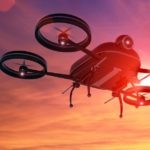Drones, the hype and their practical use
Unmanned aerial vehicles, or drones, have been with us now for four years. These devices –which just a few years ago were being sold as recreational toys for model aircraft enthusiasts– gave little hint of the real scope of this technology. Beyond their use for recreation, they were mooted as a new tool for the professional world.

Time passed and from time to time we heard rumors, and some commentators even flagged up 2014 as the year of drones. They're out there. We see numerous videos about how they work, and we read in the news everything we'll be able to do with them in the future, but how much of this is actually possible today? Is it purely hype, or are they set to take off? It's time to shed some light on the subject and take a closer look at the current situation.
Drones: the robot that wants to work with us
To understand the enthusiasm surrounding drones, we first have to know how they work and what their key features are. They are aerial vehicles that can be controlled remotely –which in itself is nothing new–, but their primary difference lies in their ease of use and the multiple functions they offer. These are devices that offer something more than simply the pleasure of piloting a small object over our heads.
Today's technology has made it possible to create a simple and affordable drone, one that we can control with our cellphone and use with other systems to create different synergies: action cameras to record unique images, and processors which –thanks to a series of sensors– can capture data and information to which we normally would not have access.
Their uses go much further than simply serving as a toy, and companies are now coming up with a whole range of useful applications. Drones fitted with a series of cameras can be used to guard property and provide closer and clearer views, livestock farmers use them to analyze the countryside from the sky to see what the terrain is like and where their livestock is, and so on.
Drones can also transform messaging services and deliver our packages to our homes. In this area it is Amazon who has invested most heavily in drones, running pilot programs to study the way to design a route, leave the package at its destination and return to base. If it succeeds, it will give them a competitive edge over many other online sales platforms.
In Spain we have projects such as Fulmar, a drone levies used to carry out border surveillance tasks in the Strait of Malacca, a region at the intersection of three countries: Indonesia, Malaysia and Singapore. In the Antarctic, a brother of this robot is used to locate shoals of tuna to make the fishing routes more efficient in this hostile region.
Why don't they come out into the open and join the mainstream?
These are just a few examples of the technology in use today with drones. These are only a few cases, but enough to show clearly that the technology is alive and well, and being used for more than merely demonstrations. So why don't they finally come out into the open and join the mainstream?
On the one hand there is the fact that it is a technology that advances slowly and is difficult to integrate. At the professional level it has proved useful in certain applications, but is not something that can be implemented across a range of different sectors and services. In the places where it can be used, it performs very effectively, but its features mean it cannot easily be deployed everywhere.
Then we have the problem of regulation. Flying a drone involves a series of legal complications. Most legal systems throughout the world today still have no clear definition with which to regulate their use and impose a series of limitations on the height at which they can fly, as airspace is very strictly controlled.
This has meant –for example– that Amazon's plans to ship via drone have been delayed and they have had to move their tests to India where the law governing drones is less stringent. When their use is finally well delimited, we can expect to see a sudden boom, as the technology is ready and being tested, and has proved to be useful in cases where it has been rolled out.